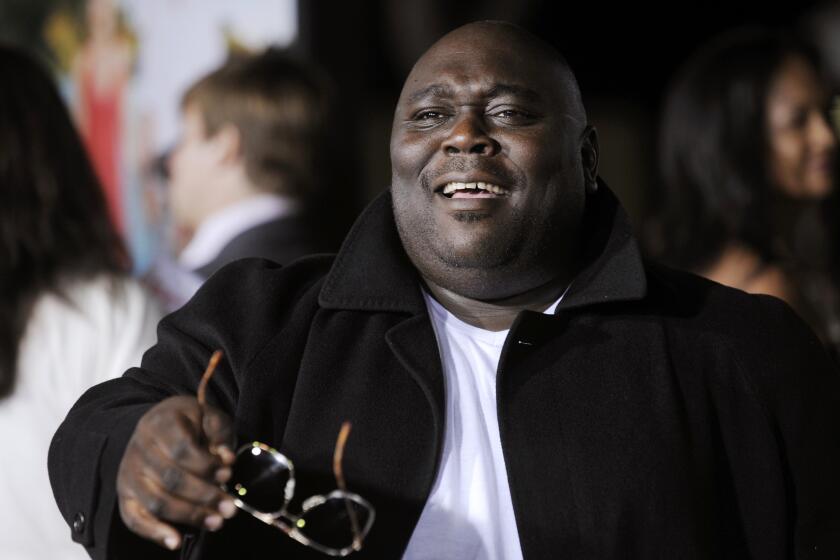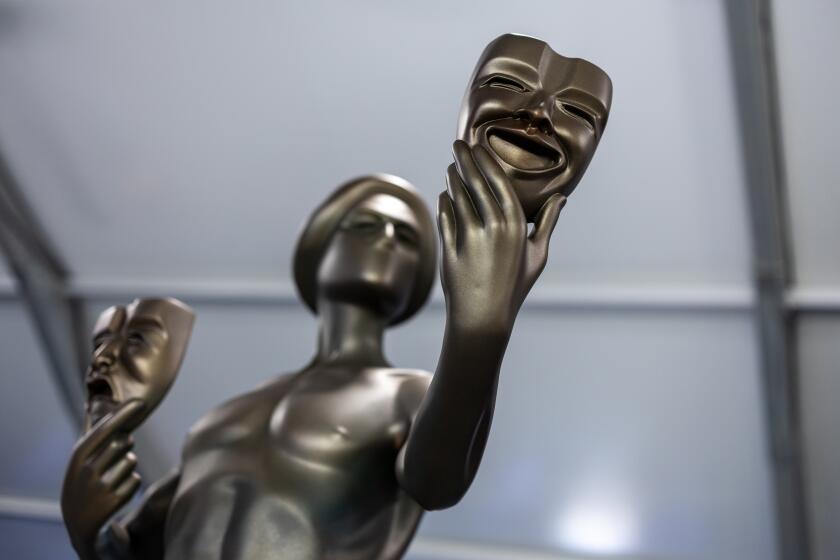The Big Read is a national page-turner
- Share via
There was no snow at the Huntington Library in Pasadena, but the four sled dogs tethered there seemed acclimated enough. One amiably licked the face of a child in a stroller. The hubbub wasn’t much like the Yukon, but the dogs were there to excite interest in Jack London’s “The Call of the Wild.”
This was a far cry from a quiet conversation around a library table -- a series of which are being held in West Hollywood to discuss Rudolfo Anaya’s “Bless Me, Ultima.” Nor was it much like the walking tour of San Francisco speak-easies for “The Great Gatsby,” or the chalk art festival in Pomona that included “To Kill a Mockingbird” as a theme.
Yet all these projects have one element in common: the Big Read.
Developed by the National Endowment for the Arts, the Big Read funds projects nationwide in an effort, NEA literature director David Kipen explains, “to restore reading to the heart of American life.”
Kipen, a tall man with a wide smile, was previously book critic at the San Francisco Chronicle; his enthusiasm seems better suited to his current role.
In addition to his duties in Washington, he has traveled the country -- once, in a Big Read-branded Ford hybrid -- visiting as many Big Read celebrations as he can.
“No two Big Reads are alike,” he says. “It’s kind of unavoidable -- and rather stirring to behold.”
Flexible program
While the projects are diverse, there is a clear structure. Each year, communities nationwide choose from the Big Read’s list of books, map out projects and submit a formal grant application.
Generally libraries or municipalities apply, but the program is flexible. In New England, a hospital -- UMass Memorial Health Care Center -- took note of research that shows readers live longer lives; this spring, they’ll do a Big Read with “The Adventures of Tom Sawyer.”
The grants, which range from $2,500 to $20,000, are small. This means that more communities can participate. The process also calls for a funding match, so each grantee should have twice that amount for programming.
In addition to money, the Big Read provides training and resources. Grantees are brought together for an annual orientation, and are given readers’ guides with accompanying audio CDs, bookmarks and other materials.
And then, they’re off: to set up a Russian potluck for Tolstoy, an exhibit of vintage soldier’s uniforms for Hemingway, or to lock in those sled dogs.
The dogs made several appearances as part of the Huntington Library’s Big Read project. The Huntington holds the largest archive of Jack London papers, so “The Call of the Wild” was a perfect fit. The library put many London items on exhibit, including his Klondike diary, a first edition of “The Call of the Wild” and an original manuscript of “White Fang.”
‘Wild’ activities
The connection to its collection is only part of the reason the Huntington chose “The Call of the Wild.” The hope was that London’s adventure tale would appeal to boys and young men, constituencies that have low reading rates, according to NEA reports.
“This is all about reaching out to nonreaders and readers at risk,” says Sue Hodson, the Huntington project’s director.
“We want to get the people who wouldn’t necessarily think to pick up a book,” Kipen adds. “And to do that, you’ve got to have a little pizazz.”
Ultimately, the Huntington’s monthlong project, one of Southern California’s most ambitious, reached 24,353 people through 95 events. More than two dozen partners -- public libraries and commercial bookstores, the Boy Scouts and the Humane Society -- contributed to activities around “The Call of the Wild.”
In Los Angeles, meanwhile, the Cultural Affairs Department designed a “full sensory experience” for its kickoff of events inspired by “The Maltese Falcon” by Dashiell Hammett.
A stage production at Barnsdall Art Park was followed by a jazz performance, a vintage car show and a visit from a falcon from the L.A. Zoo. Readings of the novel, though, were limited to students who were assigned it in school.
Kipen hopes that the Big Read will “reintroduce America to its neighbors, and give everybody something more interesting in common to talk about than the weather.”
Currently, there are 22 books on the Big Read list. That includes novels by Twain, Tolstoy and Edith Wharton, as well as 20th century classics by Fitzgerald, Hemingway and Steinbeck. There is some science fiction -- Ray Bradbury’s “Fahrenheit 451” and “A Wizard of Earthsea” by Ursula K. Le Guin-- as well as books that deal with race and culture, such as “Their Eyes Were Watching God” by Zora Neale Hurston and Amy Tan’s “The Joy Luck Club.”
One book for all?
The Big Read is doing its best to make sure there is something for everyone.
But is that really possible? What does reading mean? The idea that we should read together, talk about books and do unusual, exciting, book-related things together takes for granted that reading is a communal activity. The popularity of Oprah’s book club shows that, for many, this is the case.
For some, however, reading is highly personal, private even. “It’s still really easy for me to slip completely into the world of a book if I’m engaged with it,” says writer and lit blogger Maud Newton.
Perhaps the truth is that we want conflicting things from reading: to find someone just like us, say, or to learn about someone very different. Maybe we want to enrich our connection to the place we live, which makes San Francisco’s Hammett seem an odd choice for L.A.
We might love a fast-moving plot or prefer spending time with characters we have come to love. All these desires may exist in the same person; how, then, can anyone expect to find the right book for a whole community?
‘Ultima’ finale
For their Big Read project on “Bless Me, Ultima,” West Hollywood and PEN Center USA have examined the book’s themes of coming of age, religion and immigration. As a final event last week at the West Hollywood Library, PEN Emerging Voices fellow Sonia Quiñones led a discussion of the book.
“I hate being told what to read,” Quiñones admits. Nevertheless, she embraced “Bless Me, Ultima,” which she describes as a “really cool coming of age story.” It’s easy to identify with, she says, because everyone has wrestled with “what people want from us versus what we want for ourselves.”
Quiñones’ point speaks to the contradictory nature of the Big Read: It both tells us that reading is good for us and chooses the books we ought to read. This, of course, may make it difficult for committed readers to join in.
But then again, who doesn’t want to see a pack of sled dogs -- in Southern California, no less? If he were still around, Jack London would have been there for sure.
Kellogg writes for Jacket Copy, The Times’ book blog.
More to Read
The biggest entertainment stories
Get our big stories about Hollywood, film, television, music, arts, culture and more right in your inbox as soon as they publish.
You may occasionally receive promotional content from the Los Angeles Times.










